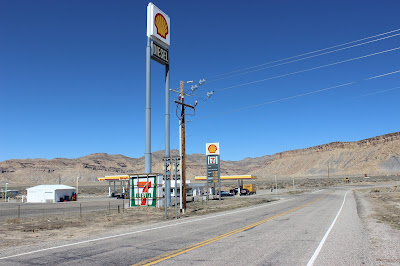Most travelers speeding east-west on I-70 through Grand County, Utah probably do not notice the small town of Thompson as they pass. Aside from the gas station, Thompson has little to attract passersby, but just north of town is Sego Canyon which is worth a second look.
Your adventure begins at Exit-187 on I-70. After leaving the interstate, turn north or Highway 94 toward the gas station that comes before you enter Thompson Springs.
You may want to fill your gas tank, get a snack or take care of other "personal business" at the Shell/7-Eleven convenience store before heading into the back country.
Just follow your nose straight on through the quiet (deserted) town of Thompson Springs. They do have some railroad tracks you may want pause and look both ways prior to crossing. Follow Highway 94 through Thompson and soon you'll see the signs to Thompson and Sego Canyons.
The winding road through Sego Canyon goes from rough pavement, to rock strewn gravel with areas of sand. At first the road is suitable for a car, but becomes a narrow, rough Jeep trail that provides a fun ride between sandstone cliffs, tall pines, and high desert landscapes. Overall, the trail is not difficult or technically challenging on a motorcycle.
The art above is credited to the Archaic people who lived in this area from 8,000 to 2,000 years ago, Experts claim these people were nomads who did not build permanent structures, but lived in caves or temporary structures. All that remains of their passing are these paintings.
These images are Barrier Canyon Style, which consists of larger than life manlike forms painted with no eyes or hollowed eyes and often no arms or legs. Over the centuries the Anasazi, Fremont, and Ute tribes also left their mark near here.
The ghost town of Sego, began as a small mining operation in the early 1890s when rancher Harry Ballard discovered coal and bought the land. By 1911 he sold the mine to a group of Salt Lake City investors who expanded the operation. The remnants of a railroad they built to haul coal is still visible in the canyon.
The old company store is missing its roof and main floor, but the floor supports still protrude though the exterior stone walls. Decades later, the stone work on the building remains remarkably solid.
At one point Sego boasted a store, a boarding house and numerous homes for miners, But, by the late 1940s, low profits and financial problems caused the mine to close and the town was eventually abandoned.
Aside from the ghost town and Native American art, the natural beauty of Sego Canyon is worth taking time to admire. I spent several hours enjoying the sights and sounds of the canyon and did not see another person the entire time I was there.
Your adventure begins at Exit-187 on I-70. After leaving the interstate, turn north or Highway 94 toward the gas station that comes before you enter Thompson Springs.
The winding road through Sego Canyon goes from rough pavement, to rock strewn gravel with areas of sand. At first the road is suitable for a car, but becomes a narrow, rough Jeep trail that provides a fun ride between sandstone cliffs, tall pines, and high desert landscapes. Overall, the trail is not difficult or technically challenging on a motorcycle.
The sandstone walls near the mouth of the canyon display ancient art from three different Native American cultures, of three separate eras. This site is listed on the National Register of Historic Places, but sadly vandals have defaced many of the painted and carved images.
The ghost town of Sego, began as a small mining operation in the early 1890s when rancher Harry Ballard discovered coal and bought the land. By 1911 he sold the mine to a group of Salt Lake City investors who expanded the operation. The remnants of a railroad they built to haul coal is still visible in the canyon.
The old company store is missing its roof and main floor, but the floor supports still protrude though the exterior stone walls. Decades later, the stone work on the building remains remarkably solid.
Since it is a ghost town, there has to be a ghost car. This battered, rusted, shell looked sadly at home resting beside a collapsed pile of dried out, splintered lumber that may have once been a home.
Aside from the ghost town and Native American art, the natural beauty of Sego Canyon is worth taking time to admire. I spent several hours enjoying the sights and sounds of the canyon and did not see another person the entire time I was there.
I would liked to have stayed longer, but approaching darkness and some threatening storm clouds convinced me to head back to the highway. Sego Canyon was a grat ride, with some interesting sites, as well. Next time you are in the area, I recommend you stop and see for yourself.
















No comments:
Post a Comment
Thanks for leaving a comment!